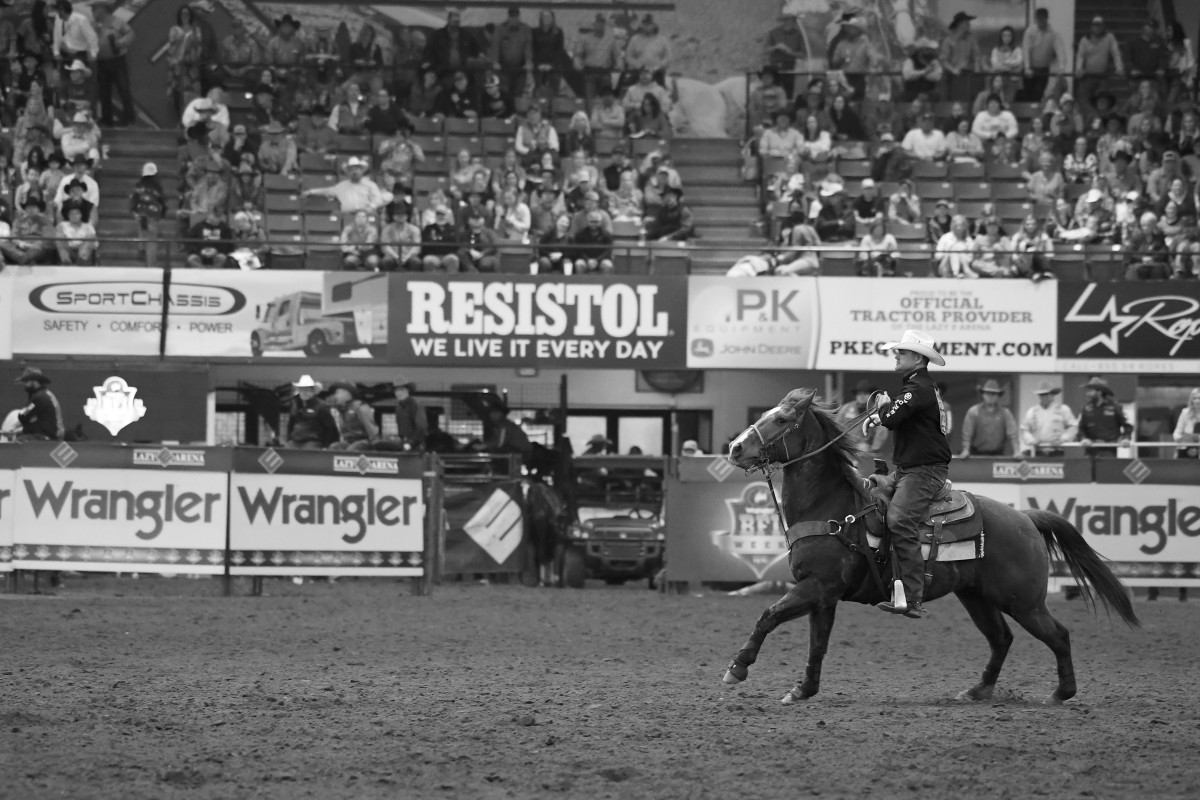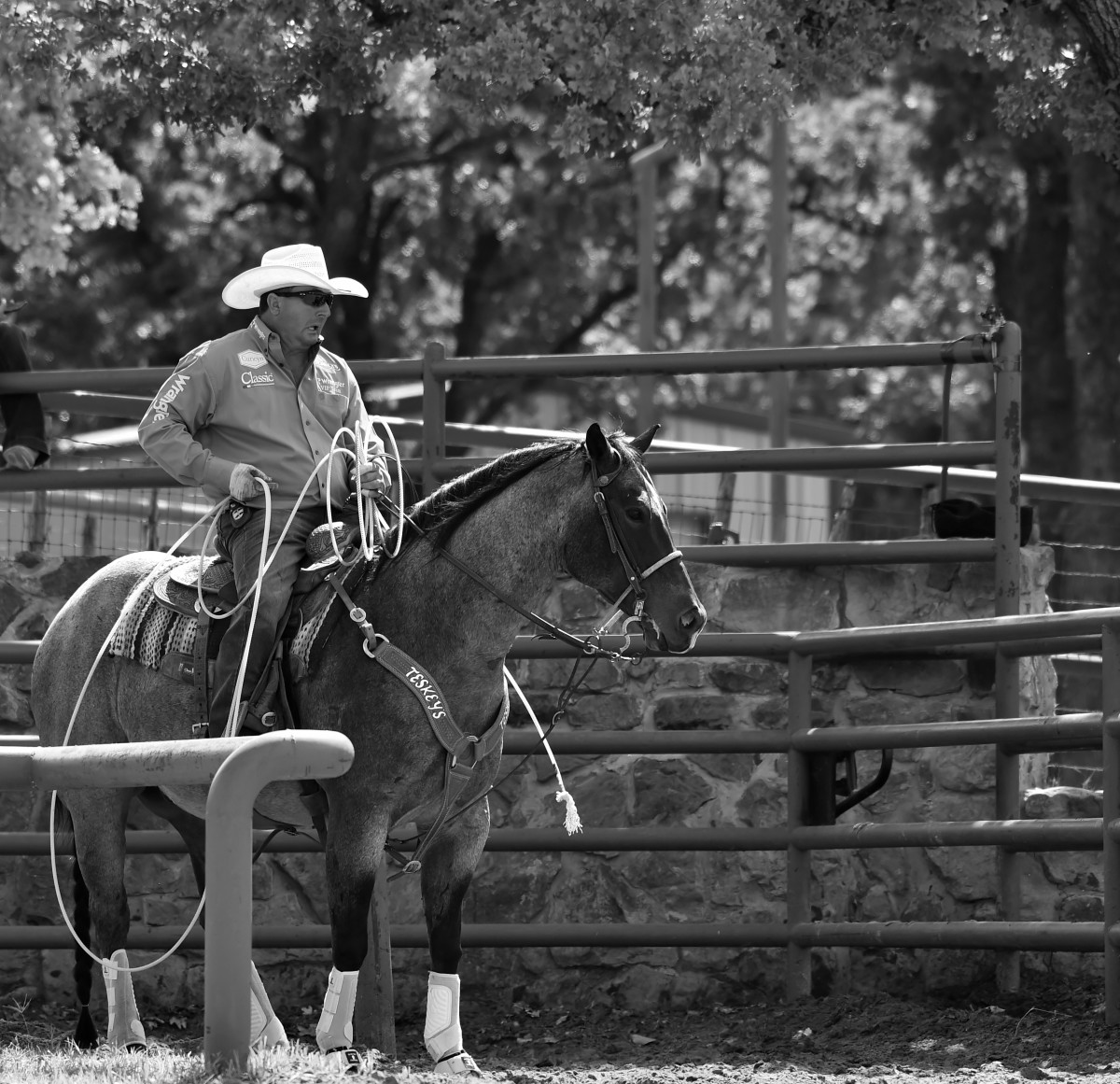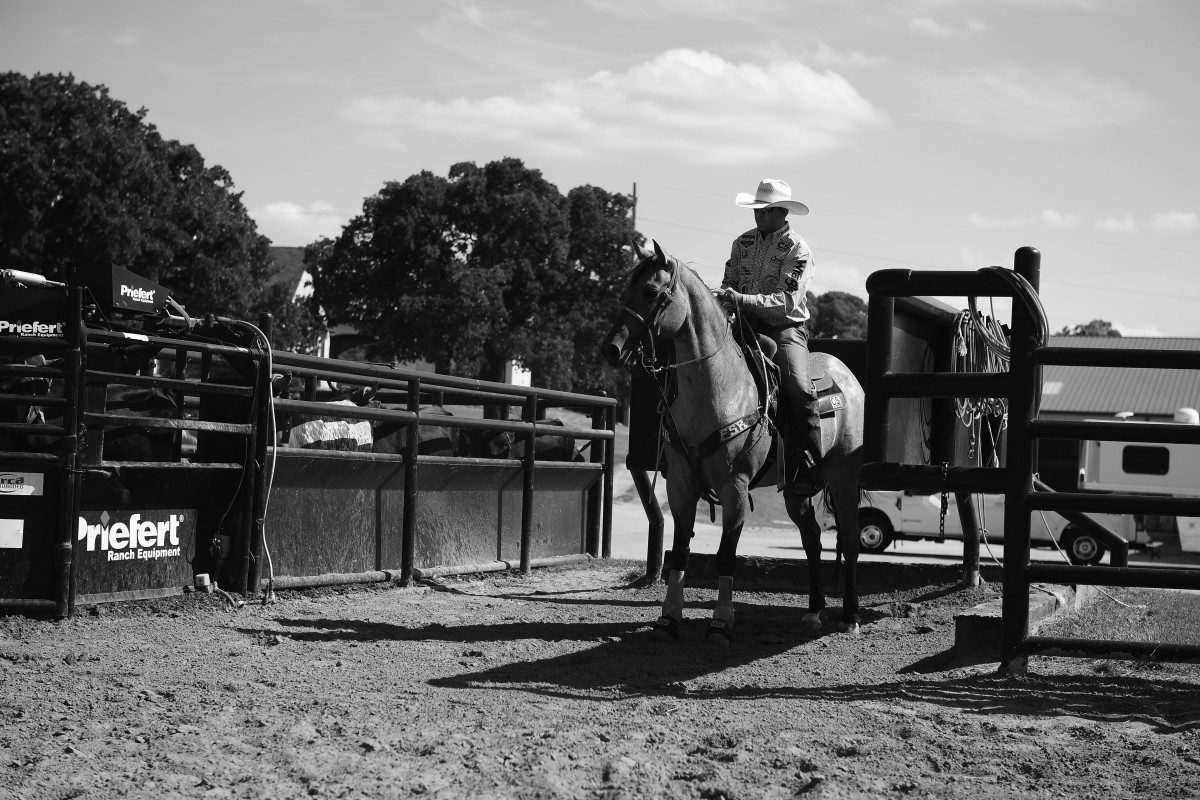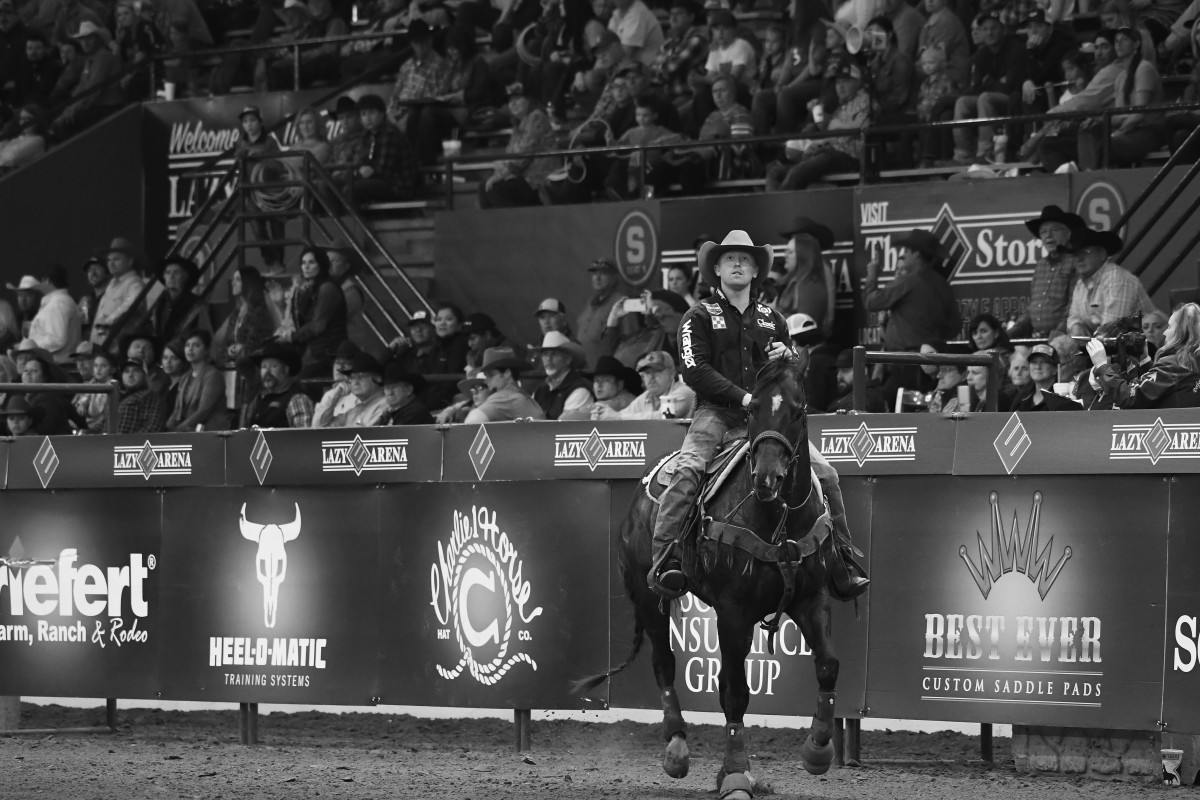When your horse gets on the muscle in the box, your chance to win money gets just as tight—and you NEED to know how to stop box problems.
Is your caballo kicking its rear end out of the corner, forcing you to stuff it back into place? Squatting or leaning back into the corner? Simply tightening head to toe like a bow string before you nod? Those things are certain to either get you out late or get you the penalty buzzer.
Luckily, some of the best hands in the business have insights on what to do.
Clay Tryan knows something about keeping a head horse cool in the corner, considering he dominates the longest scoreline in the game as the BFI’s career earnings leader.
“The tough thing about no heeling barrier is that the head horse gets to watching the heel horse leave a lot sooner than you can leave,” Tryan said. “When there’s no heeling barrier and your heeler can take off first, you need to make sure your horse is listening to you.”
It helps, he said, to relax your body. But even when a horse gets hot or tight and hangs in the box, Tryan said he doesn’t worry about being off the line at a long-score setup.
“A few inches does not make a big difference when you’re letting them out 20 feet,” he explained. “But if you break the barrier on a slow steer? That’s what will ruin your day. Because getting out clean on a slow steer is how you win.”
Tryan’s good horse, Johnson, doesn’t get hot and that’s how he bought him. In Tryan’s opinion, you buy the best horse possible so you don’t have to worry about it. But still, Tryan thinks it helps to let his horse be a horse. He kicks Johnson out in the biggest pens he can find or pasture when possible.
Racehorses, if nothing else, are known for being hot. So if any horse in the most recent BFI short round should have gotten tight, it was Jubilant Version. The super-fast, turbo-charged ex-racehorse underneath Clint Summers is known as “JV” for short, but people often joke that he’s definitely varsity.
Fast and Flat: The Secret to Teaching the Start with Trevor Brazile
Now 12, the son of Holland Ease out of a Runaway Winner daughter had five starts on the track for Reliant Ranches before being started on steers by Trevor Brazile. JV’s full brother, Winners Version, has a speed index of 103 and progeny that have earned almost $5 million on the track.
“I’d always loved that horse because he’s so fast,” said Summers, who bought JV from Wyatt Imus. “You can’t hardly beat him in long setups.”
To keep JV cool, Summers doesn’t rope on him much at home, preferring to follow slow cattle or simply score a bunch.
“He literally walks into the box like he’s here at the house walking into the barn,” Summers said. “And he will not move until you ask. I’ve never ridden a horse like him. He’s a freak. It’s crazy that he can run like that and score like that.”
Summers also has Ransom, a horse that came through Clay Smith and was also started by Brazile and Lari Dee Guy.
“They know when to push a horse and when to let off; I’ve been fortunate to spend time with Trevor and he’s dang sure helped me a whole lot,” Summers said.

Standing flat
While headers seem more prone to battle box problems, trainer Clay Logan argues that it’s no less important for your heel horse to stay chill.
“A heel horse needs to score as well as a head horse anymore,” Logan said. “If you’re a heeler and you miss the start, your whole run is in trouble.”
A great accessory that Logan uses with his young horses to keep their nerves cool is a snaked scoring lane made by Quicksilver. The lane slows cattle down just outside the chute so horses can ease out of the box and not have to make up time.
“The gates bang and you can trickle that horse across that scoreline and still hold your positioning,” Logan said. “You don’t have to just gas your heel horse real hard every time and blitz across that scoreline. That lane seems to help quite a bit in keeping them calm.”
Because many of his prospects were worked on a mechanical cow or flag on an electric pulley, Logan has an even tougher job keeping them standing calmly. Cutting trainers taught those colts to stop and draw back when they heard the clang of the flag moving. So when Logan gets them, their tendency is to rock back when the chute gates clang open. But heel horses need to stand and break flat, too.
“When a horse rocks back in the box, now you’re a little bit late,” Logan said. “So I try to move their feet and send them out gently without blasting them across there.”

Cues to Fix OR Create Box Problems
If anyone has adrenalin pumping in the box, it’s three-time NFR header Tyler Wade. He’s known for winning go-rounds and pushing horses to the max. Therefore, he’s learned to do whatever it takes to get a horse to break clean and level—in other words, to not be on the muscle in the corner.
“There are things you can do at home,” Wade says, “Like maybe set the horse a foot off the corner when you nod. And rope slow steers. You don’t want to ask a horse to go zero to 100 every time he backs into the corner. Make him know it won’t always be a pressure-filled situation.”
Especially if a horse is nervous, Wade will ask one for his life no more than one out of every 10 runs until he feels some trust develop. He wants his horse calm, cool and collected in the corner of the box.
“And focus on your cues,” he said. “Make sure you’re not squeezing with your calf muscles. A lot of times, if my horse is nervous I’ll swap bits around so that I’m pulling a little less or pulling a little more. Make sure you have the right equipment. A horse has to understand your cues; you can’t be pulling and kicking at the same time.”
To Wade, it’s more effective to rope slow cattle and let a horse relax on the approach than it is to score several in a row. For instance, on a very slow steer, he may walk his horse out of the box when the steer is released, only squeezing with his feet once he’s 40 feet out in front of the box. Then he makes sure to come back into the box and let his horse rest in the corner.
“Horses need to realize that corner can be a release point, too,” he said. “My horse doesn’t get to quit moving his feet until he’s in the corner, then he looks forward to that spot to take a break. I hate to see any roper sit on their horse in a line waiting their turn at a practice session, because that horse is getting rested outside the box. It makes them dread going back into it.”
Wade limits his practice to one or two other people so he can rope, then ride right back into the box and sit there a minute or two, giving his horse a rest break inside the box. And he’ll always score the last steer and loosen his cinch in there.

Boiling Points and Box Problems
“If you’re at the end of your rope and you’ve tried everything, look into products from Simply Equine, OE Nutraceuticals or Equinety,” Wade said. “If your horse is hot, it could be his back hurting or something else that needs maintenance to relieve pain. Those three companies have something to help line that out. If your horse has always been really good and then comes up with a nervous issue, start with how he’s feeling before you go to training on him.”
Someone who’s ridden countless prospects and road warriors from the heading box to the pay window is Hall-of-Famer Tee Woolman, who says it helps to be able to read the horse.
“Some horses are just going to get hotter, so you’ve got to know their boiling points,” said Woolman, who mostly heels at jackpots when he’s not training and selling horses. “It depends on a horse’s age, but you don’t want to push one over that point. I don’t mind getting a horse right up to it, but don’t want to push him over it. Then let the horse cool off and think about it before you come back and add a little more pressure. You just build as you go.”
Once a horse gets nervous, the last thing Woolman will do is step out of the saddle. He wants to ride one through it. While someone else is roping, he’ll ride in and out of the box between their runs, letting his horse sit in that box a minute. He’ll keep riding in, resting and going out until there’s a change in attitude.
One aspect of a horse’s chill factor that Logan mentioned is hauling and seasoning. Don’t forget to do some of these relaxation drills away from home, too, he said.
“Last year, because so much was shut down due to Covid, our colts got hauled to some big events without much seasoning, so it blew their skirt up a little when we asked them for everything,” said Logan, who’s finally recovering from a recent pelvis and hamstring injury.
Obviously, it’s a complex effort, keeping a horse calm and cool in the corner. But if you add pressure slowly, make the corner a place of rest sometimes, and don’t ask a horse for its life on every trip, you’re on your way.
The biggest takeaway here is uncovering your own inadvertent cues. For instance, if you have no idea that every time you nod, your thigh muscles tighten, you’ll never understand why your horse tightens during the nod and therefore jumps when the gates clang. And that never gets you out perfectly.

Try this
What if you’re already in the corner with a hot mess? Consider these tips:
• Move those hooves
Some horses get hotter the more you mess with them. But moving their feet from left to right and breaking loose their shoulders gets them more relaxed than backing in and holding pressure [Summers]. Walking some circles and knocking that horse off your hands and feet helps, so when you back into the corner he’s thinking more about you than those gates opening [Woolman].
Improving Light Feet with Logan Olson
• Take a deep breath
When the music’s getting louder and you’re nervous on the inside, take a deep breath and relax and pet your horse. Sometimes when you help calm your horse, it actually calms you, too, when all that money’s on the line [Summers]. Is your grip on the reins too tight? Are you holding your breath in the corner? Learn how to breathe, even if you have to stick your tongue on the roof of your mouth [Woolman].
WPRA World Champion Hope Thompson breaks down what taking a deep breath does for her and her horse. This applies to breakaway roping and team roping. Read here: The Breakaway Roper’s Last Breath
• Make a mental note for when you get home
Analyze video and common denominators. Ask yourself, “Do I have more than one horse doing this?” Horses listen to every move you make, so be cautious about what your body is signaling [Wade].
What Not to Do
Mistakes can be made when nerves are tense and a horse is hot, hot, hot. According to Clint Summers, Tyler Wade, Clay Logan, and Tee Woolman, whatever you do, do not:
• Get in a big hurry
Back in there and nod, but only as fast as it works out.
• Overlook weird head movements or stances, even at jackpots
All that does is teach a horse to do something undesirable and makes it a habit.
• Worry about prancing or habits that don’t affect the horse listening in the corner
Punishing a horse for prancing just adds more pressure.
• Completely reset your horse if he wriggles out of the corner
Turning a horse away from the steer is usually a release point; instead just ride forward and backward.
• Get off
Instead, ride him through the madness. Don’t keep roping, but keep riding to give him time to think about it.
• Engage in battle
Just work through the ups and downs. Never turn it into a disaster.
Want more team roping tips? Subscribe to Roping.com today.











